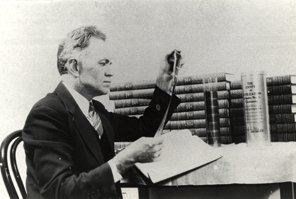Name Thomas Peters Role Inventor | Spouse Grace Margaret Price Parents William Isbestos Peters | |
 | ||
Born June 27, 1879 Norfolk, Virginia, USA Occupation newsreel cameraman, photographer, and inventor Known for early motion picture development Died 1973, California, United States | ||
Thomas Kimmwood Peters (June 27, 1879 – 1973) was a pioneer American motion picture producer, newsreel cameraman, photographer, educator, and inventor.
Contents
- Education
- Association with the motion picture industry
- Association with Oglethorpe University
- Outline of career
- Authored works
- Inventions
- Newsreel footage
- References
Education
Association with the motion picture industry
Peters began his photography work in the motion picture industry around 1899, with the Pathe Freres film company of France. Later, when he left them, he continued to work throughout Europe at various companies in the motion picture industry to develop his skills. He also did photography and motion picture work at Karnak and Luxor in Egypt.
Peters was associated with the Cosmos Film Company in San Francisco, California, which later became Exactus Photo Film Corporation of Palo Alto. He became its first president and general manager when it officially started operations on August 28, 1914. The company stated that its purpose was
In the beginning, Exactus had a list of well-respected California educators to serve on its board of directors. However, a lack of good business management and closing skills in obtaining financial backing caused its failure only two years later. There were also clashes of misunderstandings between the educators and Exactus' technicians that exacerbated the situation. By the end of 1916, Peters held an auction of the physical items held by the bankrupt company to raise money to pay off its creditors. What little stock left was turned over to the Palo Alto Film Company.
Peters kept the technical and educational value of the Exactus films at a high quality in spite of these tumultuous times. At the Panama-Pacific International Exposition in 1915, his company won two gold medals and one bronze medal for films they had produced.
Association with Oglethorpe University
Thornwell Jacobs, originator of the Crypt of Civilization (the world's first modern time capsule located at Oglethorpe University), hired Peters to serve as the project archivist and general manager of development and construction.
One of the reasons Peters was hired was for his unique skills in photography. He used his knowledge to preserve on microfilm and film footage items to be entered in the Crypt for a 6,000-year storage. Peters recorded on film such historical figures as Adolf Hitler and Joseph Stalin. He also included President Franklin D. Roosevelt and Benito Mussolini.
Peters and his staff of student assistants worked on the Crypt project from 1937 until 1940 when it was sealed permanently. They put on cellulose acetate microfilm many historical events of the 19th and 20th centuries. The microfilm reels were placed into airtight receptacles for preservation. The staff and Peters initiated backup methods in case the acetate didn't survive. One method Peters developed was duplicate "metal film." It was as thin as paper.
Peters also worked on developing Oglethorpe University's historical photographic collections. Peters was also director of the China Air Force School at Oglethorpe University, 1945-46. He was also professor of audio-visual education at the university.
According to Oglethorpe University Peters had been the only newsreel photographer to film the San Francisco earthquake of 1906 and the associated fire. He was also the first to film the construction of the Panama Canal.
Outline of career
Authored works
Inventions
Newsreel footage
Early film of the 1906 San Francisco earthquake aftermath. Views of destruction taken from a vehicle moving east down Market Street.
